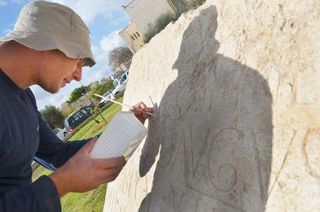Rare Inscription Hailing Emperor Hadrian Unearthed in Jerusalem

A newly uncovered large slab of limestone with an official commemoration to the Roman Emperor Hadrian may help researchers understand the events that led to the Bar Kokhba revolt in the early second century, experts said.
The finding is both rare and tremendous, and may be one of the most important Latin inscriptions ever uncovered in Jerusalem, the researchers said.
Yet, the fragmented stone served more than one purpose throughout the ages. After ancient officials inscribed the commemoration, others recycled the limestone and used it to build a cistern, a container for storing water. [See Photos of the Newfound Hadrian Inscription]
Scientists with the Israel Antiquities Authority found the stone while excavating sites north of the Damascus Gate, an entrance to the Old City of Jerusalem, this past year. The slab weighs about a ton and is 1.5 meters by 1 meter (5 feet by 3.3 feet) in size, according to the Israel Antiquities Authority.
"We found the inscription incorporated in secondary use around the opening of a deep cistern," Rina Avner and Roie Greenwald, excavation directors on behalf of the Israel Antiquities Authority, said in a statement. "In antiquity, as today, it was customary to recycle building materials, and the official inscription was evidently removed from its original location and integrated in a floor for the practical purpose of building the cistern. Furthermore, in order to fit it with the capstone [of the cistern], the bottom part of the inscription was sawed round."
Monumental find
As soon as they saw the size of the slab and clarity of the Latin text, the researchers knew they had uncovered a significant piece of history. Archaeologists have unearthed just a small number of ancient, official Latin inscriptions in Israel, and this is one of the most important of them, the researchers said.
Sign up for the Live Science daily newsletter now
Get the world’s most fascinating discoveries delivered straight to your inbox.
The inscription includes six lines of Latin writing, which Avner Ecker and Hannah Cotton, both from the Hebrew University of Jerusalem, translated into English, as follows:
"To the Imperator Caesar Traianus Hadrianus Augustus, son of the deified Traianus Parthicus, grandson of the deified Nerva, high priest, invested with tribunician power for the 14th time, consul for the third time, father of the country (dedicated by) the 10th legion Fretensis Antoniniana."

Legio X Fretensis, a legion of the Roman Empire, dedicated the inscription to Emperor Hadrian in the year 129-130, Ecker and Cotton said.
Surprisingly, the inscription is the right half of a larger piece of text discovered more than 100 years ago, they said. French archaeologist Charles Clermont-Ganneau found the other part of the inscription in the late 19th century, and it now resides in the courtyard of the Studium Biblicum Franciscanum Museum in Jerusalem.
The new find is a rare discovery, especially because it mentions the name and titles of Hadrian, an extremely prominent emperor, and a clear date. Hadrian, famous for the wall named after him in Roman England, ruled from 117 to 138. He consolidated the Roman Empire and rebuilt the Pantheon; philosopher Niccolò Machiavelli called him one of the "Five Good Emperors," who earned the respect of his people through good rule. [Photos: The Secret Passageways of Hadrian's Villa]
The second part of the inscription provides confirmation that the Tenth Legion, a division of the Roman army, was in Jerusalem during the period between two revolts — the destruction of the Second Temple in year 70 and the Bar Kokhba revolt of the Jews against their persecutors in the Roman Empire from 132 to 136. The inscription may even name the location of the legion's military camp in the city and alludes to one of the reasons for the Bar Kokhba revolt several years later — the establishment of "Aelia Capitolina," a Roman colony in Jerusalem.
Hadrian's full name, Publius Aelius Hadrianus, is incorporated into the colony's name, experts noted.
Hadrian's travels
Although Machiavelli called Hadrian a good emperor, Jewish history remembers him for issuing decrees that persecuted Jews and forced them to convert, which led, in part, to the Bar Kokhba revolt.
The contemporary Roman historian Cassius Dio chronicled the revolt, and also mentioned Hadrian's visit to Jerusalem in 129-130, as the emperor traveled through the eastern empire. Hadrian's trip is also documented on coins that commemorated the occasion, and in inscriptions engraved in the different cities he visited. The newfound engraving is likely one of the engravings made to honor Hadrian on his tour of the empire.
"The inscription itself might have [been] set in the top of a free-standing triumphal arch on the city's northern boundary such the Arch of Titus in Rome," Avner said.
The inscription may help researchers understand the historical factors that led to the Bar Kokhba revolt, such as whether the construction of Aelia Capitolina and the construction of a pagan temple on the site of the Jewish Temple Mount led to the revolt. Or these two events were putative measures Hadrian took against Jerusalem in the revolt's aftermath, experts said.
The researchers plan to present their findings at a conference, which is open to the public, Thursday (Oct. 23) at Hebrew University of Jerusalem. The inscription will go on display once they publish their findings.
Follow Laura Geggel on Twitter @LauraGeggel and Google+. Follow Live Science @livescience, Facebook & Google+. Original article on Live Science.

Laura is the archaeology and Life's Little Mysteries editor at Live Science. She also reports on general science, including paleontology. Her work has appeared in The New York Times, Scholastic, Popular Science and Spectrum, a site on autism research. She has won multiple awards from the Society of Professional Journalists and the Washington Newspaper Publishers Association for her reporting at a weekly newspaper near Seattle. Laura holds a bachelor's degree in English literature and psychology from Washington University in St. Louis and a master's degree in science writing from NYU.











